Simulation Model Construction of Plant Height and Leaf Area Index Based on the Overground Weight of Greenhouse Tomato: Device Development and Application
Abstract
1. Introduction
2. Materials and Methods
2.1. Test Scheme
2.1.1. Simulation Modeling Test for Leaf Area and Plant Height in Tomato
2.1.2. Operational Testing of Real-Time Tomato Aboveground Weight Monitoring Device
2.1.3. Real-Time Weight-Based Simulation Model Construction Experiment for Leaf Area and Plant Height of Tomatoes
3. Results
3.1. Relationship of Tomatoes’ Morphological Organs with Plant Height and Leaf Area
3.2. Simulation Modeling of Tomato Plant Height and Leaf Area Index
3.2.1. Model Construction
3.2.2. Model Validation
3.3. Tomatoes’ Aboveground Fresh Weight Real-Time Monitoring Device Operation Detection
3.3.1. Long-Term Monitoring of the Weight of Constant-Weight Objects
3.3.2. Measurement Accuracy Test of Tomato Aboveground Fresh Weight Device in Different Periods
3.4. Simulation of Tomato Plant Height and Leaf Area Index Model Based on Real-Time Monitoring Device
3.4.1. Calculation Method of Tomato Stem and Leaf Distribution Coefficient
3.4.2. Model Simulation Construction of Plant Height and LAI Based on Dynamometer
3.4.3. Application Test of Plant Height Model
3.4.4. Application Test of Leaf Area Index Model
4. Discussion
5. Conclusions
Supplementary Materials
Author Contributions
Funding
Data Availability Statement
Acknowledgments
Conflicts of Interest
References
- National Greenhouse Data Device. Available online: http://data.sheshiyuanyi.com/AreaData/ (accessed on 1 November 2023).
- Yang, S.Y.; Liu, X.; Liu, S.Y.; Chen, X.Y.; Cao, Y.F. Real Time Temperature Distribution Monitoring in Chinese Solar Greenhouse Using Virtual LAN. Agronomy 2022, 12, 1565. [Google Scholar] [CrossRef]
- Li, T.L. Development Status of China’s Facility Vegetable Industry and Outlook. China Veg. 2023, 9, 1–6. [Google Scholar]
- Yu, X.M.; Zhang, J.W.; Zhang, Y.H.; Ma, L.L.; Jiao, X.C.; Zhao, M.F.; Li, J.M. Identification of optimal irrigation and fertilizer rates to balance yield, water and fertilizer productivity, and fruit quality in greenhouse tomatoes using TOPSIS. Sci. Hortic. 2023, 311, 11829. [Google Scholar] [CrossRef]
- Bonotto, D.M.; Wijesiri, B.; Goonetilleke, A. Nitrate-dependent Uranium mobilisation in groundwater. Sci. Total Environ. 2019, 693, 133655. [Google Scholar] [CrossRef]
- Wu, B.F.; Tian, F.Y.; Zhang, M.; Piao, S.L.; Zeng, H.W.; Zhu, W.W.; Liu, J.G.; Elnashar, A.; Lu, Y.M. Quantifying global agricultural water appropriation with data derived from earth observations. J. Clean. Prod. 2022, 358, 131891. [Google Scholar] [CrossRef]
- Liu, W.F.; Liu, X.C.; Yang, H.; Ciais, P.; Wada, Y. Global Water Scarcity Assessment Incorporating Green Water in Crop Production. Water Resour. Res. 2022, 58, e2020WR028570. [Google Scholar] [CrossRef]
- Rozenstein, O.; Fine, L.; Malachy, N.; Richard, A.; Pradalier, C.; Tanny, J. Data driven estimation of actual evapotranspiration to support irrigation management: Testing two novel methods based on an unoccupied aerial vehicle and an artificial neural network. Agric. Water Manag. 2023, 283, 108317. [Google Scholar] [CrossRef]
- Tian, Y.Q.; Gao, L.H. Theory and Technology for Facility Cultivation of High-quality Tomato. China Veg. 2021, 2, 30–40. [Google Scholar]
- Kehili, M.; Choura, S.; Zammel, A.; Allouche, N.; Sayadi, S. Oxidative stability of refined olive and sunflower oils supplemented with lycopene-rich oleoresin from tomato peels industrial by product, during accelerated shelf-life storage. Food Chem. 2018, 246, 296–304. [Google Scholar] [CrossRef]
- Liu, Z.L.; Gao, J.J.; Gu, D.Y.; Zhang, Y.Y.; Jiao, J.; Liu, S.Q.; Tian, X.F. Effects of nitrogen fertilizer levels on quality, yield and nutrient absorption of substrate cultivation tomato in solar greenhouse. J. Arid Land Resour. Environ. 2019, 33, 7. [Google Scholar]
- Nam, D.S.; Moon, T.; Lee, J.W.; Son, J.E. Estimating transpiration rates of hydroponically grown paprika via an artificial neural network using aerial and root zone environments and growth factors in greenhouses. Hortic. Environ. Biotechnol. 2019, 60, 913–923. [Google Scholar] [CrossRef]
- Fan, S.N.; Ji, Y.H.; Liu, M.C.; Li, W.; Liang, H.; Wu, Z.H.; Wang, L.P. Physiological responses of tomato leaves to different irrigation rates. Water Sav. Irrig. 2023, 1, 19–25. [Google Scholar]
- Ali, G.F.; Mahmoud, R.-S.; Ali, S.; Hamid, Z. Non-destructive estimation of sunflower leaf area and leaf area index under different water regime managements. Arch. Agron. Soil Sci. 2015, 61, 1357–1367. [Google Scholar] [CrossRef]
- Liu, Z.K.; Niu, X.Y.; Wang, Y.; Hang, W.T. Estimation of plant height of winter wheat based on UAV visible image. J. Triticeae Crops 2019, 39, 859–866. [Google Scholar]
- Li, J.; Shen, L.X.; Zhang, K.L.; Li, B.N. Effects of drip irrigation soluble organic fertilizer on tomato growth and quality. Water Sav. Irrig. 2022, 12, 37–41. [Google Scholar]
- Elnaz, A.; Mohammad, G.; Jan, M.; Petr, K.; Marek, K. Impacts of environmental factors and nutrients management on tomato grown under controlled and open field conditions. Agronomy 2023, 13, 916. [Google Scholar]
- Tao, H.B.; Lin, B. Comparison on disc method with copy method and length-width method for measuring leaf area of rice. Plant Physiol. Commun. 2006, 42, 496. [Google Scholar]
- Dai, Z.C.; Du, D.L.; Si, C.C.; Lin, Y.; Hao, J.L.; Sun, F. A method to exactly measure the morphological quantity of leaf using Scanner and Image J Software. Guihaia 2009, 29, 342–347. [Google Scholar]
- Pan, T.H.; Wang, Y.L.; Yang, J.W.; Xi, L.J.; Ding, J.J.; Zhang, J.J.; Zou, Z.R. Screening and Optimization of Rapid Measurement Method for Leaf Area of Vegetable Seedlings. China Veg. 2018, 8, 64–69. [Google Scholar]
- Bacci, L.; Battista, P.; Rapi, B. Evaluation and adaptation of TOMGRO model to Italian tomato protected crops. N. Z. J. Crop Hortic. Sci. 2012, 40, 115–126. [Google Scholar] [CrossRef]
- Wang, X.; Diao, M.; Ma, F.F.; Fan, H.; Cui, J.; He, H.B. Simulation of leaf area, dry matter production and accumulation of processing tomato with drip irrigation. Agric. Mach. 2014, 45, 161–168. [Google Scholar]
- Wang, D.; Guo, S.B.; Liu, F.H.; Cao, Y.F. Adaptation and application of development stage model for greenhouse pepper in Guanzhong area. J. China Agric. Univ. 2023, 28, 74–86. [Google Scholar]
- Chang, Y.B.; Li, J.M.; Shang, X.M.; Zhang, D.L.; Pan, T.H.; Du, Q.J. Simulation of tomato morphology growth with water-fertilizer coupling. J. Northwest A F Univ. (Nat. Sci. Ed.) 2015, 43, 126–133. [Google Scholar]
- Cheng, C.; Dong, C.Y.; Li, Z.F.; Gong, Z.H.; Feng, L.P. Simulation model of external morphology and dry matter accumulation and distribution of celery in solar greenhouse. Trans. Chin. Soc. Agric. Eng. 2021, 37, 142–151. [Google Scholar]
- Zhai, Z.H.; Chen, X.W.; Gao, L.P.; Zhang, T.Z. Simulation of greenhouse cucumber plant height growth based on gradient boosting algorithm. J. China Agric. Univ. 2022, 27, 134–145. [Google Scholar]
- Xu, L.H.; Meng, F.Z.; Wei, R.H. Development and verification of tomato crop-environment interaction model in second timescale greenhouse. Trans. Chin. Soc. Agric. Eng. 2021, 38, 212–222. [Google Scholar]
- Lee, J.H.; Goudriaan, J.; Challa, H. Using the expolinear growth equation for modelling crop growth in year-round cut chrysanthemum. Ann. Bot. 2003, 92, 697–708. [Google Scholar] [CrossRef] [PubMed][Green Version]
- Wang, D.D.; Lv, Z.N.; Li, J.; Ma, J.M.; Sun, Z.P. Comparison of dry matter partitioning model of tomato cultivated with growth-bag during different growing seasons based on product ofthermal effectiveness and photosynthesis active radiation in solar greenhouse. Acta Agric. Boreali-Occident. Sin. 2018, 27, 238–243. [Google Scholar]
- Luo, W.H.; Li, Y.X.; Dai, J.F.; Jin, L.; Xu, G.B.; Chen, Y.S.; Chen, C.H. Simulation of greenhouse tomato drt matter partitioning and yield prediction. Chin. J. Appl. Ecol. 2006, 05, 811–816. [Google Scholar]
- Guo, S.B.; Liu, F.H.; Wang, D.; Huang, B.; Cao, Y.F. Constrution of tomato growth rate simulation model based on climate suitability index. Chin. J. Agrometeorol. 2023, 44, 611–623. [Google Scholar]
- Liu, H.J.; Shao, M.X.; Yang, L. Photosynthesis Characteristics of Tomato Plants and Its’ Responses to Microclimate in New Solar Greenhouse in North China. Horticulturae 2023, 9, 197. [Google Scholar] [CrossRef]
- Cao, Y.F.; Shi, M.; Liu, X.; Ding, J.J.; Li, J.M.; Sun, Y.C. Effects of thermal insulation projection on indoor light environment and tomato growth performance in plastic greenhouse. Trans. Chin. Soc. Agric. Eng. 2021, 37, 190–196. [Google Scholar]
- Flores-Velázquez, J.; Rojano, F.; Aguilar-Rodríguez, C.E.; Villagran, E.; Villarreal-Guerrero, F. Greenhouse Thermal effectiveness to produce tomatoes assessed by a temperature-based index. Agronomy 2022, 12, 1158. [Google Scholar] [CrossRef]
- Shi, X.H.; Cai, H.J.; Zhao, L.L.; Yang, P.; Wang, Z.S. Greenhouse tomato dry matter production and distribution model under condition of irrigation based on product of thermal effectiveness and photosynthesis active radiaton. Trans. Chin. Soc. Agric. Eng. 2016, 32, 69–77. [Google Scholar]
- Sun, S.K.; Wang, X.T.; Xu, J.T.; Fu, H.D.; Sun, Z.P. Study of tomato growth weight distribution model based on real time plant weight in a solar greenhouse. J. Taibah Univ. Sci. 2021, 15, 1027–1037. [Google Scholar] [CrossRef]
- Lin, D.Y.; Wei, R.H.; Xu, L.H. An Integrated Yield Prediction Model for Greenhouse Tomato. Agronomy 2019, 9, 873. [Google Scholar] [CrossRef]
- Liu, F.H.; Guo, S.B.; Wang, D.; Huang, B.; Cao, Y.F. Construction and verification of an external morphology, substance accumulation, and distribution model of tomatoes in greenhouse. Trans. Chin. Soc. Agric. Eng. 2022, 38, 188–196. [Google Scholar]
- Gao, H.; Wu, F.Z.; Zhou, X.G.; Gao, D.M.; Yang, W.J. Effects of sub-low temperature on dry matter accumulation, nitroge and phosphours absorption and distribution in different tomato cultivars. Acta Agric. Boreali-Occident. Sin. 2018, 27, 994–1001. [Google Scholar]
- Li, S.L.; Li, Y.; Zhou, L.J.; Niu, X.X.; Yu, L.M. Quantitative assessment of temperature suitability of alpine summer tomato seeding in west of Henan province. Trans. Chin. Soc. Agric. Eng. 2019, 35, 194–202. [Google Scholar]
- Doan, C.C.; Munehiro, T. Relationships between tomato cluster growth indices and Ccumulative environmental factors during greenhouse cultivation. Sci. Hortic. 2022, 295, 110803. [Google Scholar] [CrossRef]
- Qu, Z.Y.; Sun, H.H.; Yang, B.; Gao, X.Y.; Wang, L.M.; Wang, L.P. Effects of different amendments on soil microorganisms and yield of processing tomato in saline alkali soil. Trans. Chin. Soc. Agric. Mach. 2021, 52, 311–318. [Google Scholar]
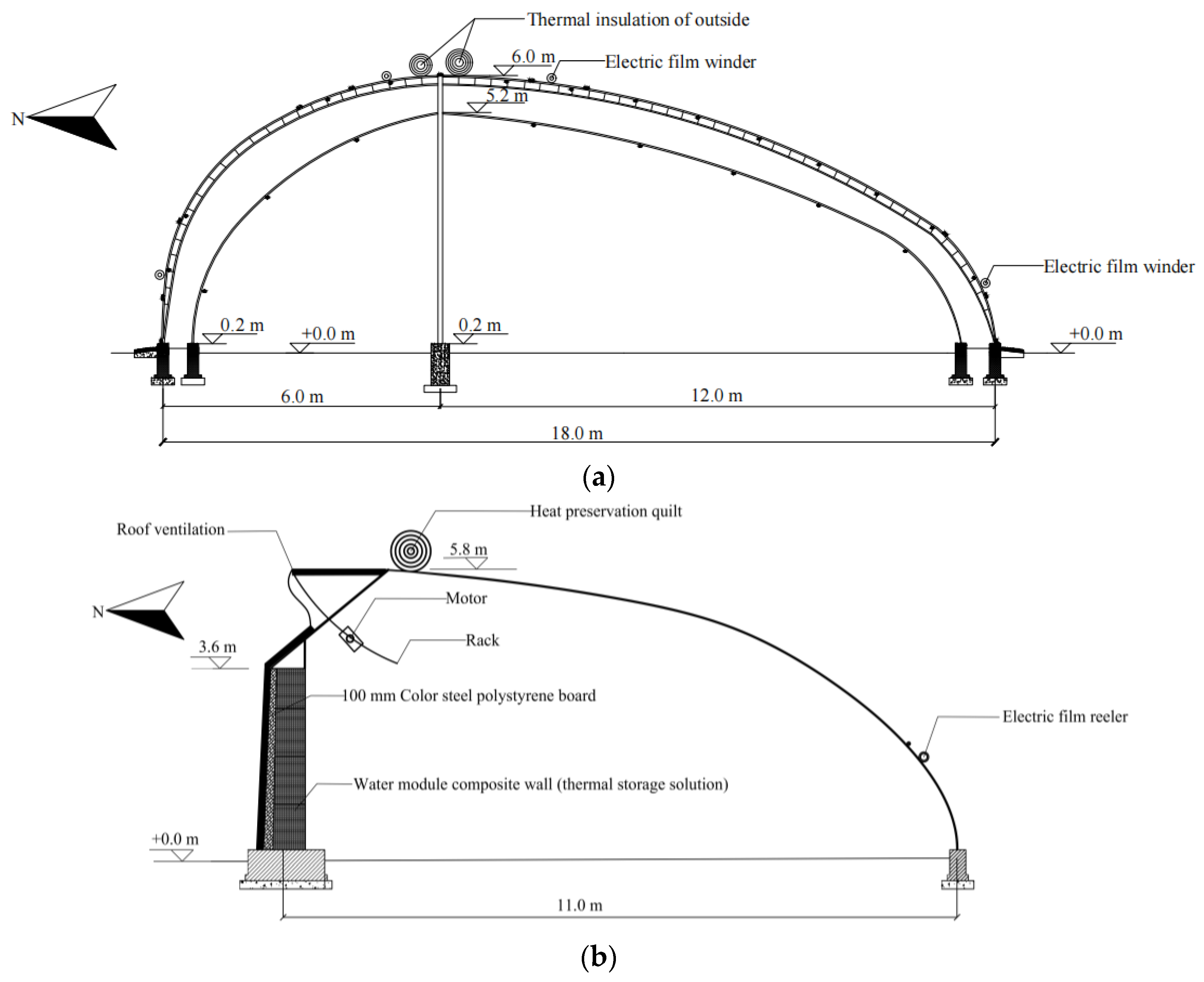



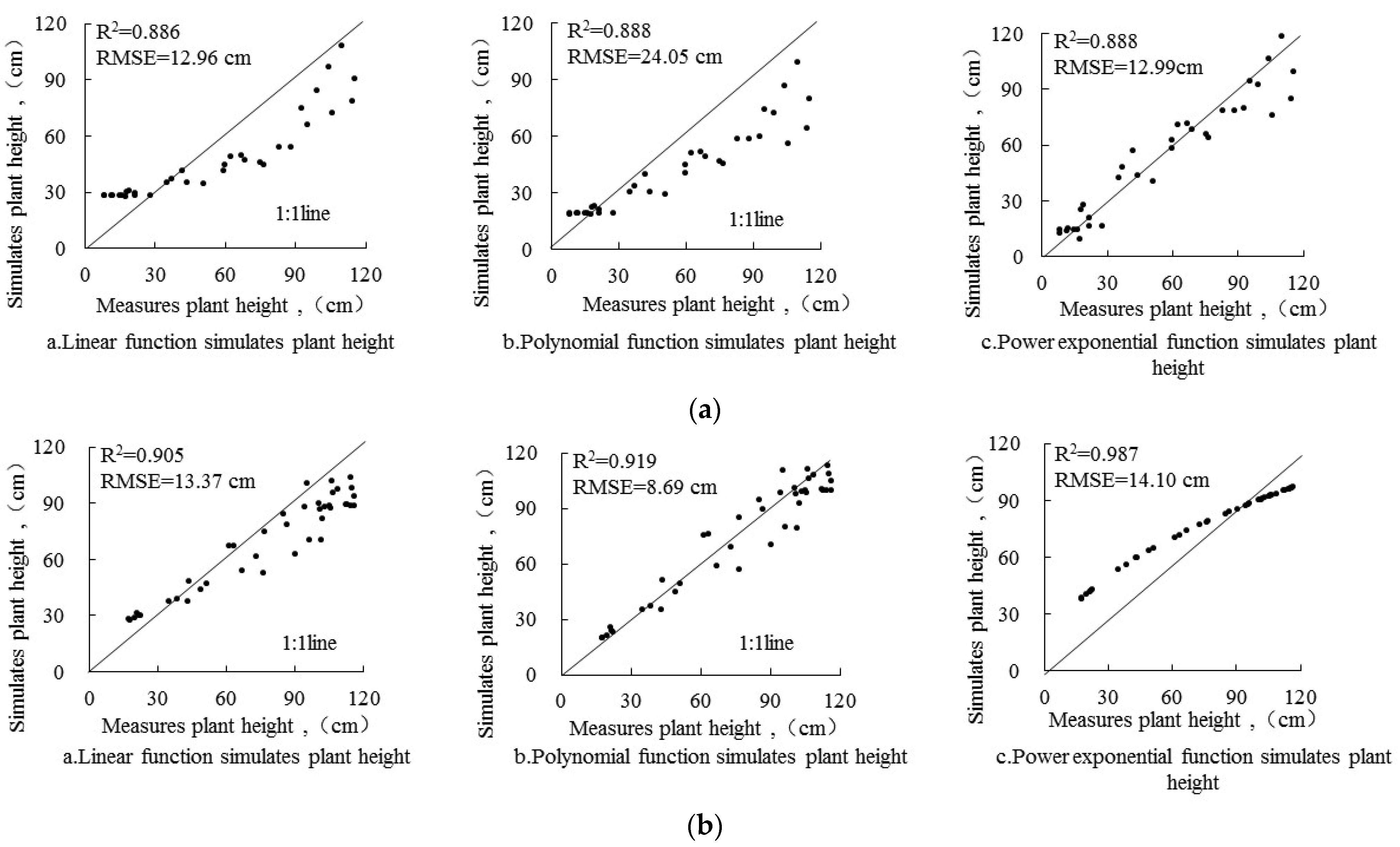
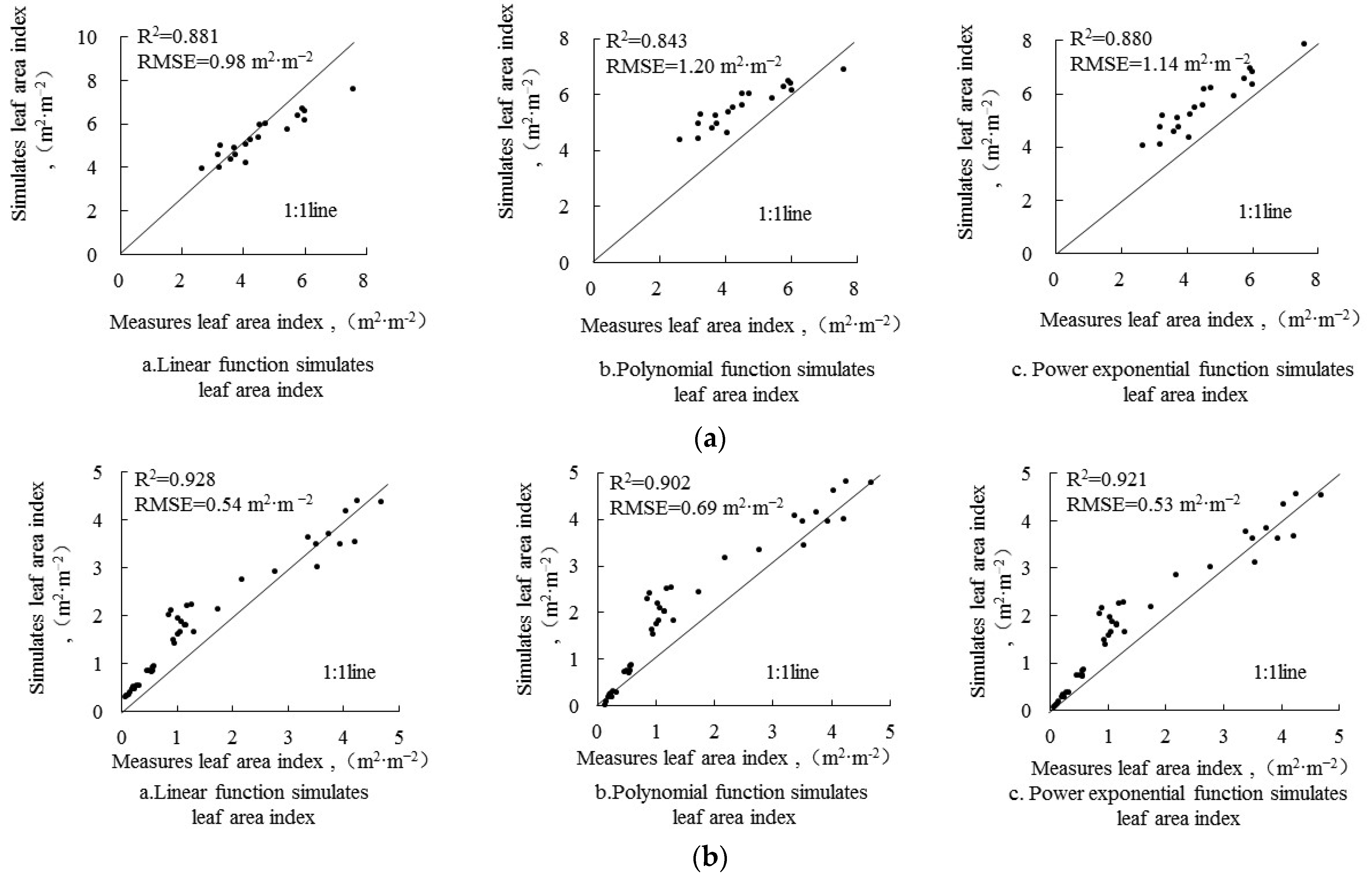
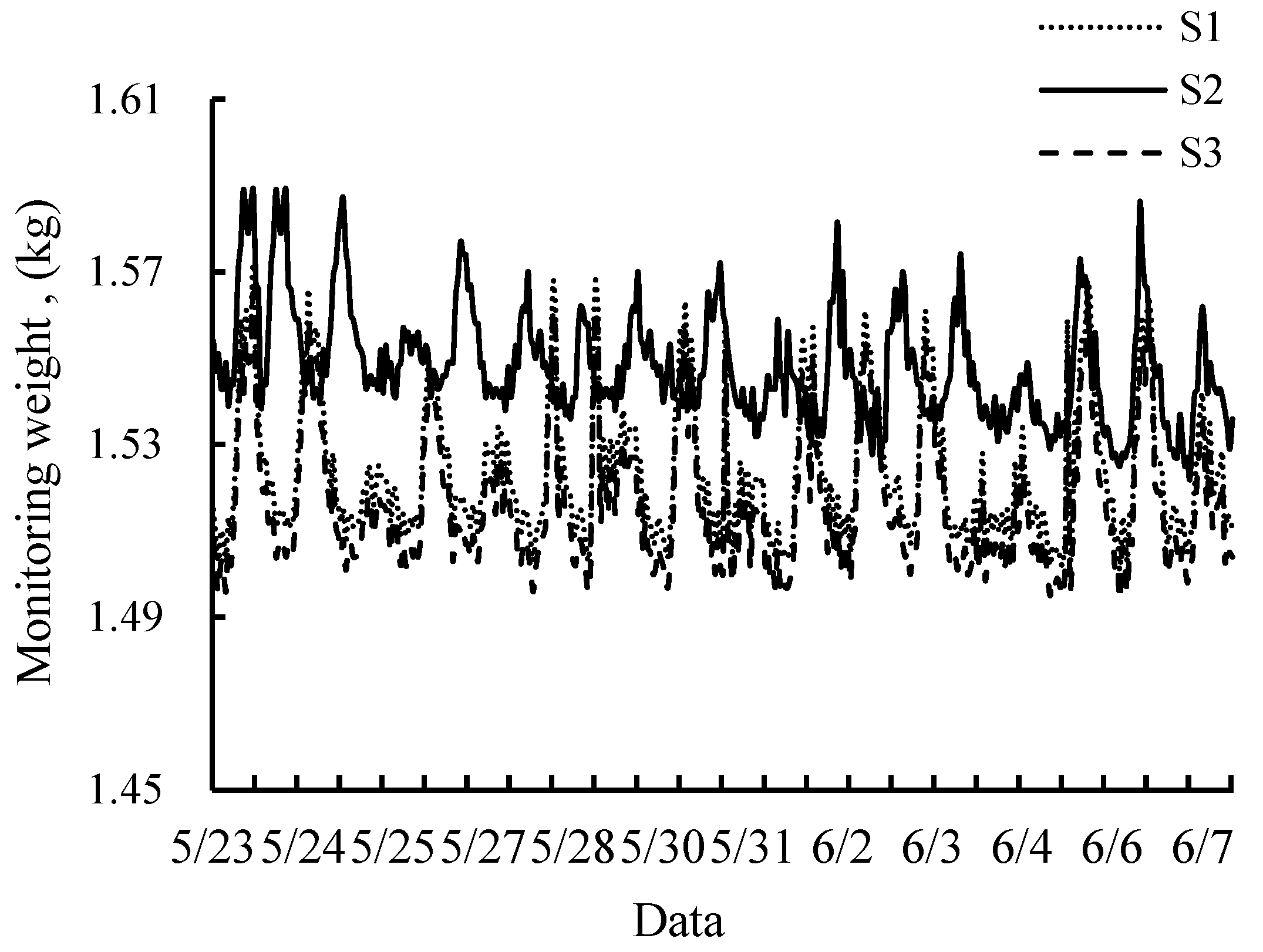
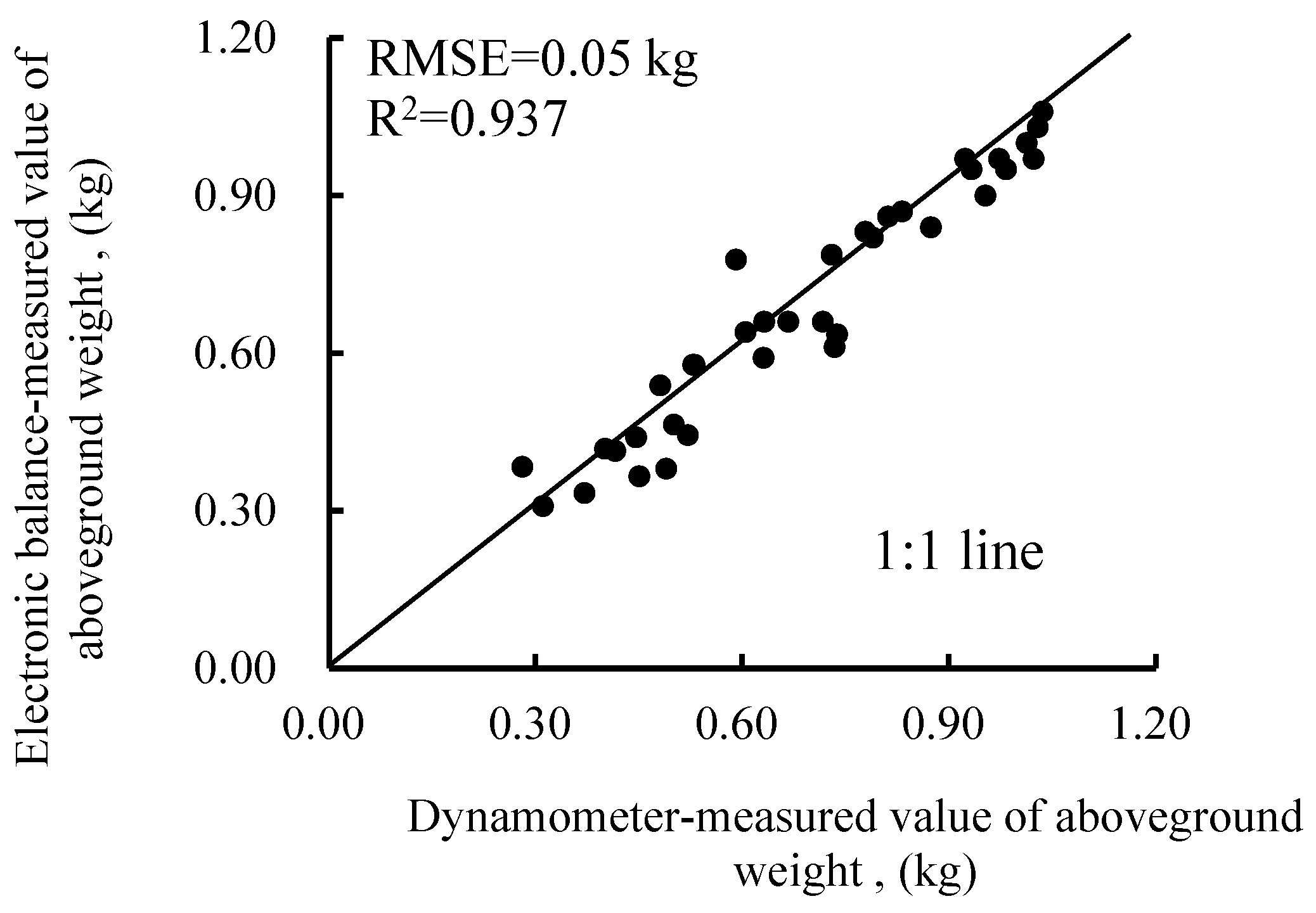
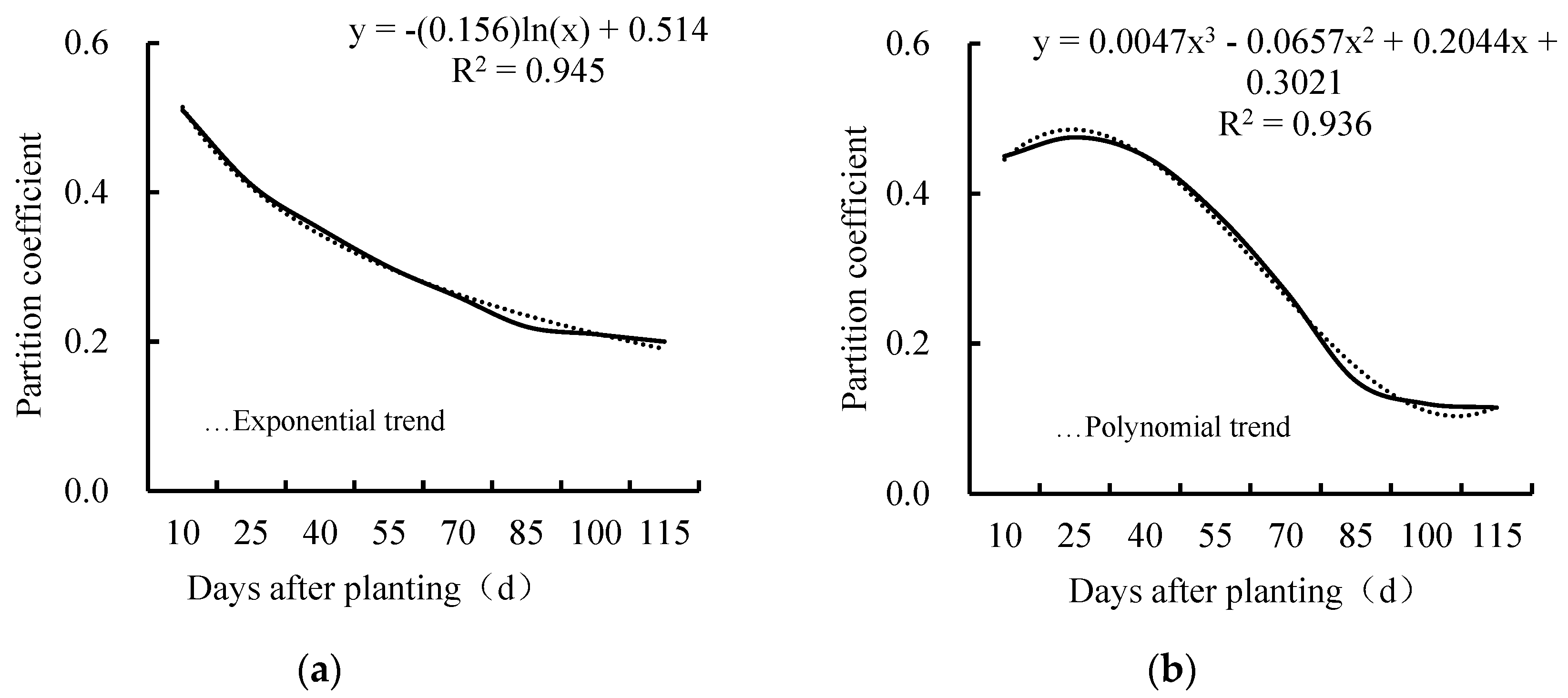
| Stubble | Stem Fresh Weight | Leaf Fresh Weight | ||||
|---|---|---|---|---|---|---|
| Spring stubble | Plant height | r | 0.930 ** | Leaf area | r | 0.952 ** |
| p | 0.001 | p | 0.001 | |||
| Autumn stubble | Plant height | r | 0.944 ** | Leaf area | r | 0.984 ** |
| p | 0.001 | p | 0.001 | |||
| Tomato Appearance | Math Function Types | Model |
|---|---|---|
| Plant height (H) | Linear function | |
| Polynomial Function | ||
| Idempotent function | ||
| Leaf area (LA) | Linear function | |
| Polynomial Function | ||
| Idempotent function | ||
| Leaf area index (LAI) | / |
| Name | Model |
|---|---|
| Distribution factor | |
| Linear function | |
| Polynomial function | |
| Idempotent function |
| Name | Model |
|---|---|
| Distribution factor | |
| Linear function | 6 |
| Polynomial function | |
| Idempotent function | |
| Leaf area index (LAI) |
| Test Greenhouse Type | Name | R2 | RMSE (cm) |
|---|---|---|---|
| Solar greenhouse | Linear function | 0.813 | 4.46 |
| Polynomial function | 0.818 | 6.71 | |
| Idempotent function | 0.835 | 4.89 | |
| Multispan plastic greenhouse | Linear function | 0.858 | 9.24 |
| Polynomial function | 0.711 | 21.86 | |
| Idempotent function | 0.870 | 17.71 |
| Test Greenhouse Type | Name | R2 | RMSE (m2·m−2) |
|---|---|---|---|
| Solar greenhouse | Linear function | 0.950 | 0.20 |
| Polynomial function | 0.955 | 0.18 | |
| Idempotent function | 0.953 | 0.12 | |
| Multispan plastic greenhouse | Linear function | 0.748 | 1.04 |
| Polynomial function | 0.651 | 0.52 | |
| Idempotent function | 0.870 | 1.22 |
Disclaimer/Publisher’s Note: The statements, opinions and data contained in all publications are solely those of the individual author(s) and contributor(s) and not of MDPI and/or the editor(s). MDPI and/or the editor(s) disclaim responsibility for any injury to people or property resulting from any ideas, methods, instructions or products referred to in the content. |
© 2024 by the authors. Licensee MDPI, Basel, Switzerland. This article is an open access article distributed under the terms and conditions of the Creative Commons Attribution (CC BY) license (https://creativecommons.org/licenses/by/4.0/).
Share and Cite
Guo, S.; Wu, L.; Cao, X.; Sun, X.; Cao, Y.; Li, Y.; Shi, H. Simulation Model Construction of Plant Height and Leaf Area Index Based on the Overground Weight of Greenhouse Tomato: Device Development and Application. Horticulturae 2024, 10, 270. https://doi.org/10.3390/horticulturae10030270
Guo S, Wu L, Cao X, Sun X, Cao Y, Li Y, Shi H. Simulation Model Construction of Plant Height and Leaf Area Index Based on the Overground Weight of Greenhouse Tomato: Device Development and Application. Horticulturae. 2024; 10(3):270. https://doi.org/10.3390/horticulturae10030270
Chicago/Turabian StyleGuo, Shenbo, Letian Wu, Xinwei Cao, Xiaoli Sun, Yanfei Cao, Yuhan Li, and Huifeng Shi. 2024. "Simulation Model Construction of Plant Height and Leaf Area Index Based on the Overground Weight of Greenhouse Tomato: Device Development and Application" Horticulturae 10, no. 3: 270. https://doi.org/10.3390/horticulturae10030270
APA StyleGuo, S., Wu, L., Cao, X., Sun, X., Cao, Y., Li, Y., & Shi, H. (2024). Simulation Model Construction of Plant Height and Leaf Area Index Based on the Overground Weight of Greenhouse Tomato: Device Development and Application. Horticulturae, 10(3), 270. https://doi.org/10.3390/horticulturae10030270





